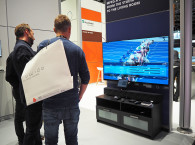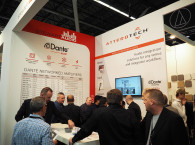
At recent media-centric shows such as NAB and IBC, together with the topic of Ultra High Definition (UHD), High Dynamic Range (HDR), and High Frame Rate (HFR) video, we have now started to see the term Next Generation Audio or NGA being used a lot. NGA is frequently used to describe the new immersive sound formats that go together with the new broadcast/media distribution video formats, either channel-based or object-based (e.g., Dolby Atmos and MPEG-H), but also to describe practices that are now understood to be dependent on IP-based workflows and distribution platforms, as both The Institute of Electrical and Electronics Engineers (IEEE) and The Society of Motion Picture and Television Engineers (SMPTE) recommend. These practices consider the fact that media will reach the consumer through a complex network of services that encompasses content delivery networks (CDNs) and Internet Delivery Systems using popular delivery protocols such as MPEG DASH, Adobe HDS, Apple HLS, and Microsoft Smooth Streaming. Even the latest broadcast standards such as ATSC 3.0 and DVB-UHD support IP multicast and hybrid broadcast (Internet) delivery using MPEG DASH (and so does Netflix, by the way).
To support these new distribution methods, the transition to IP-based infrastructures is unstoppable. These operations are now being moved to fully networked systems, cloud-based, and even being "virtualized" - which is another buzzword to describe the process of allocating production, operational, and transmission resources wherever they are available on a network, local or distributed, requiring infrastructures to be software defined. That in itself is a topic for another editorial.
But let’s go back to audio. AoIP has expanded to become one of the most important audio technologies today. Even home studios and musicians have started to replace USB and other computer interfaces with networked solutions. After proprietary and Ethernet layer 2 solutions, including Audio Video Bridging (AVB) initially caught some traction with the studio and live sound crowds - thanks in great part to Apple's native support in macOS - the media industries moved on to fully IP-compliant solutions. In the last five years, Audinate's Dante protocol took that market, expanded to become the audio installation "de facto" standard and now it even competes with other established audio protocols (e.g., Ravenna and Livewire) in the critical broadcast and media production space. And meanwhile, thanks to the industry's efforts and the Audio Engineering Society (AES), we have gained an interoperability standard called AES67. This provided the industry with the trust that the debate was over and we’re definitely ready to go all AoIP. But as IBC 2018 demonstrated, in practice, things are slightly more complicated.
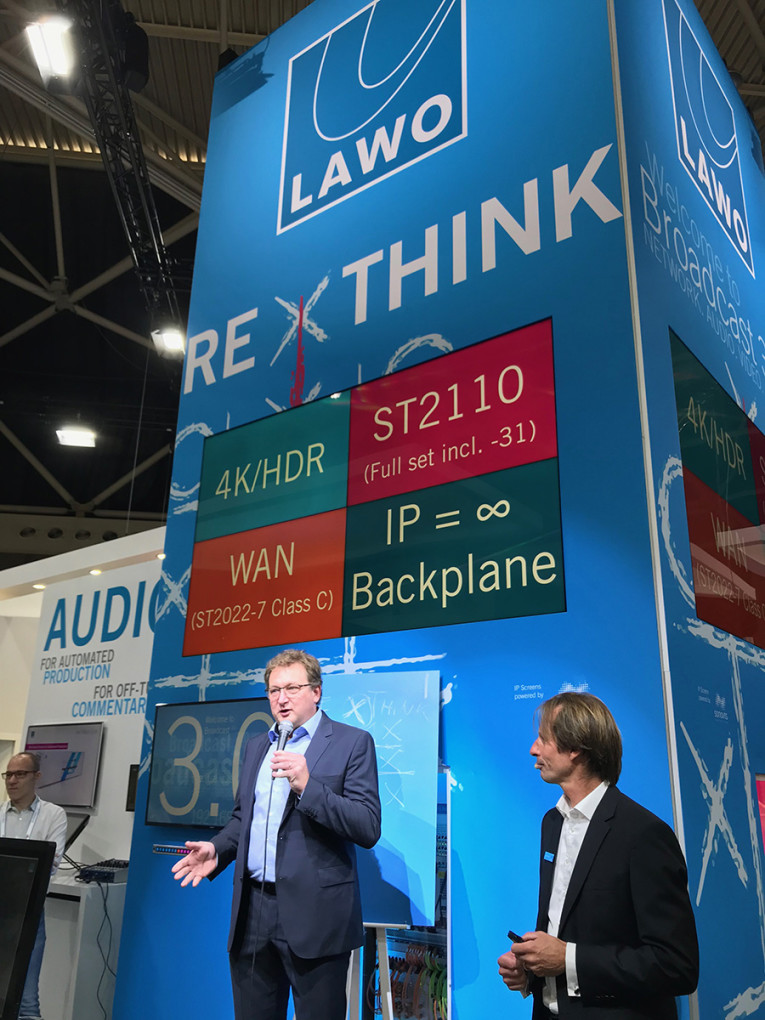
Audio professionals, whether they are working in recording studios, live productions, facility management, or broadcast/content production, are now conscious of the advantages of working with networked systems, and they are confident that they are able to adopt flexible solutions based on any of the existing popular protocols such as Dante, Ravenna, Q-LAN, and Livewire+ (widely adopted on radio), knowing they will be able to connect and interchange audio whenever needed thanks to the AES67 interoperability standard. And effectively, that's a great start.
As I've documented in the past, the companies and the audio consortiums that have propelled these protocols and standards have joined the larger-scope efforts ongoing in broadcast and content production industries, represented by the Alliance for IP Media Solutions (AIMS), Advanced Media Workflow Association (AMWA), and reinforced with the promotion of organizations such as the National Association of Broadcasters (NAB), the European Broadcasting Union (EBU), and SMPTE. This means the AoIP roadmap is now a part of a larger industry effort, as established at recent trade shows by the IP Showcase demonstrations. In those efforts, we find widespread support as these industries have never seen. This includes the support of virtually all manufacturers, from Arista to Cisco, Sony and Yamaha.
During IBC 2018, AIMS promoted another round of demonstrations, displaying how standards-based IP signal transport and IP infrastructures will power the future of these industries. More importantly, this was the first IBC show since the SMPTE ST-2110 suite of standards was ratified, which signals a new level of integration of those systems over IP, away from the previous focus of migration from SDI to IP.

The publication in May 2018 of the SMPTE ST-2110 Professional Media Over Managed IP Networks documents defined the foundational standards for essence-based transmission of video, audio, and metadata in real-time professional media applications, and now forms the backbone of the transition to IP. That's why it is not surprising to see some audio companies more frequently mentioning their own audio systems as "ST-2110," instead of their own protocol “flavors.”
The latest SMPTE ST 2110-40 standard, part of the suite, maps ancillary data packets into Real-Time Transport Protocol (RTP) packets that are transported via User Data Protocol/Internet Protocol (UDP/IP) and enables those packets to be moved synchronously with associated video and audio essence streams. This was important to allow the migration from SDI. The ST-2110 standards suite also specifies the carriage, synchronization, and description of separate elementary essence streams over professional IP networks in real time for live production, playout, and other professional media applications, separately routing the individual essence streams (audio, video, and ancillary data), which simplifies, for example, the addition of captions, subtitles, and Teletext, as well as tasks such as the processing of multiple audio languages and types, and enables the efficient carriage of NGA formats that require metadata.
This is the environment with which audio protocols need to cope, with SMPTE ST-2110 offering full native support for AES67/Ravenna, Dante, and even MADI audio streams. But it is also important to understand that this "support" also means that any exchange of audio among different protocols is established with AES67, created to generate interoperability, not replace any of the existing "flavors." And in that regard, AES67 imposes operational limitations.
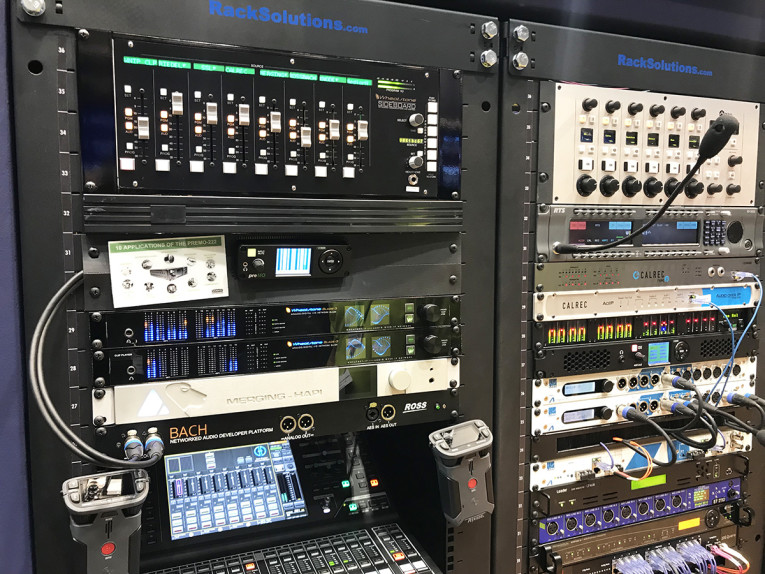
Within the continuously moving landscape of 2110 infrastructures, this poses new challenges as requirements change. As described in the standard, AES67 addresses the synchronization mechanism, encoding format, and QoS provision for delivering audio data as well as connection management functions associated with audio delivery using existing and standard protocols and technology. It "does not invent new protocols or technologies; rather, defines how to use existing protocols as a system in an interoperable manner."
As AES67 is not intended to be a solution on its own, but rather "providing means for exchanging audio streams between areas with different networking solutions or technologies," this means that users will have to choose which solutions they will use with any of the fully featured protocols. Even though there are discussions of future developments in control solutions (AES70) and possible adoption of new discovery and registration mechanisms (e.g., the Networked Media Open Specifications, NMOS is proposing), those will most probably be built on top of the existing protocols, not replacing any of them. And at IBC 2018 we have seen interesting signs on how companies are responding to this complexity.
With the widest adoption of all AoIP protocols (by more than 400 companies and integrated into more than 1,400 commercially available products), Audinate's Dante has slowly but steadily shown progress on these fronts. Availability of Dante firmware 4.1 for the Ultimo UXT family of audio networking chipsets, now enables support for AES67. As we repeatedly have heard from Audinate, the company's priorities are always based on requirements from the industry. At IBC 2018, Audinate was demonstrating SMTPE 2110, with enhancements that it intends to implement "by the end of 2018." For now, Audinate is focused on expanding its support to manufacturers (at IBC, Audinate announced new low-channel count Audio Adapter Modules) and improving its Dante Domain Manager software, the IT-grade administration and control platform, which is now a foundational platform to deal with large networked systems. To pave the way for future improvements, Audinate also previewed Dante Updater, a new feature in its Dante Controller software that will automatically update firmware on devices from all partner manufacturers.
Regarding Dante support of SMPTE ST-2110, Joshua Rush, Senior Vice President of Marketing and Products at Audinate, confirmed that, "The new products and features we are demonstrating at IBC underscore our commitment to have the Dante platform provide the performance, security, and scalability to guide our partners and customers through this rapid shift to audio-over-IP.” They also confirm SMPTE ST-2110 "will be enabled through the Dante Domain Manager platform and firmware updates for Dante IP Core, Dante HC, Dante Brooklyn II, and Dante Broadway," the company's modules and chips, which are at the core of all Dante-enabled products.
Interestingly, Audinate is also testing the ground on new fronts, and announced a cooperation with the SDVoE Alliance, an industry consortium driving standardization of "no-compromise AV signal transport over Ethernet," to create an integrated AV control environment for AV distribution and processing applications that demand zero-latency. Audinate has joined the SDVoE Alliance as a contributing member since this would enable an integrated, interoperable way to control video over IP alongside Dante audio, focusing more on commercial installation, digital signage, and conferencing.
This SDVoE Alliance effort is another good example of how certain vertical markets tend to look at things from their isolated perspective and ignore what happens in other (sometimes more powerful) forums. And that's one of the reasons why audioXpress covers and reports on all different application segments from consumer audio to broadcast and telecoms. All efforts like this seem to have merit, until the day they are confronted with something else, such as a relevant video-over-IP standard. We've seen this happen with HDBase-T and AVB before... They all serve a purpose and sometimes work fine on closed islands. But I have no doubt that Audinate knows what it is doing, and it will be interesting to follow developments on this front and see if there will be any interoperability with ST-2110.
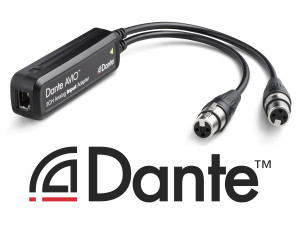 At least, as Joshua Rush restates, “Audinate is committed to interoperability as foundational to the value we provide our customers, partners, and the industry. Nowhere is this more evident or important than in the broadcast community where dual requirement for standards compliance and advanced functionality place interoperability as an essential premium.”
At least, as Joshua Rush restates, “Audinate is committed to interoperability as foundational to the value we provide our customers, partners, and the industry. Nowhere is this more evident or important than in the broadcast community where dual requirement for standards compliance and advanced functionality place interoperability as an essential premium.”Apart from Audinate, which has visible support from multiple booths and brands at trade shows like IBC, there's of course Ravenna, the more discreet but by no means less powerful "AoIP flavor," which is in fact very widely adopted in the broadcast and content production industry and recently gained support from Dolby and other strong names. Ravenna is fully AES67 and ST-2110 compliant from the days these standards were defined. Of course, it helps that Ravenna has the backing from powerful names in the industry, and benefits from total commitment and investments from Lawo in ALC NetworX, the development support arm for Ravenna.

At IBC this year, I did speak briefly with Andreas Hildebrand (ALC NetworX), known as THE Ravenna Evangelist, as well as members from Archwave, DirectOut, Merging Technologies, and other companies supporting the Ravenna developments, to learn about how their efforts keep expanding in this environment. But probably the most important sign was what I saw and heard at the Lawo press conference, where not a single time was the name Ravenna was mentioned. Instead, Lawo now prefers to mention only ST-2110. That's understandable, because there's total correspondence between how the Ravenna protocol was defined and how it supports the 2110 standards suite, since it was primarily an AoIP technology designed for the professional broadcast market, and Lawo now has increasing interests on the video side of IP applications.
So, it is not a coincidence that, when we approached other companies at IBC and whenever a company reference AES67 and ST-2110, that we were forced to ask if it was Ravenna and what they actually implemented. Others would specifically mention Dante, if that's what they used, or had clear labels of Livewire+ if it was a manufacturer of radio products.

A great example was one of the best surprises at the show for me. French mavericks of cutting-edge audio technologies, Trinnov extended its range of MC and D-Mon series processors now with AoIP options. These respond to application needs in immersive audio for both cinema rooms and mixing studios with high channel count processing solutions, which truly benefit from networked solutions. Trinnov had already implemented a Dante solution for the studio, and now offers AES67 options on its MC Processors to provide 64 input and output channels over the network with two dedicated network ports for redundancy. Of course, the AES67 model is based on Ravenna and is fully AES67/SMPTE 2210-30 compatible. The Dante models use an Audinate board and also provide AES67 compatibility. But you need to choose which one you want to use.
All the guys involved on the Ravenna front, from those previously mentioned companies, are doing a great work, and I wasn't surprised to find Kevin Lyver, President of Ward-Beck Systems, a Canadian manufacturer and strong proponent of AES67, Ravenna, and ST-2110 (as well as AES70) together with Andreas Hildebrand, leading the audio demos at the IP Showcase. In fact, as Lawo highlighted, Ravenna is now ST-2110, and that's what most of the systems on the IP Showcase racks were using.
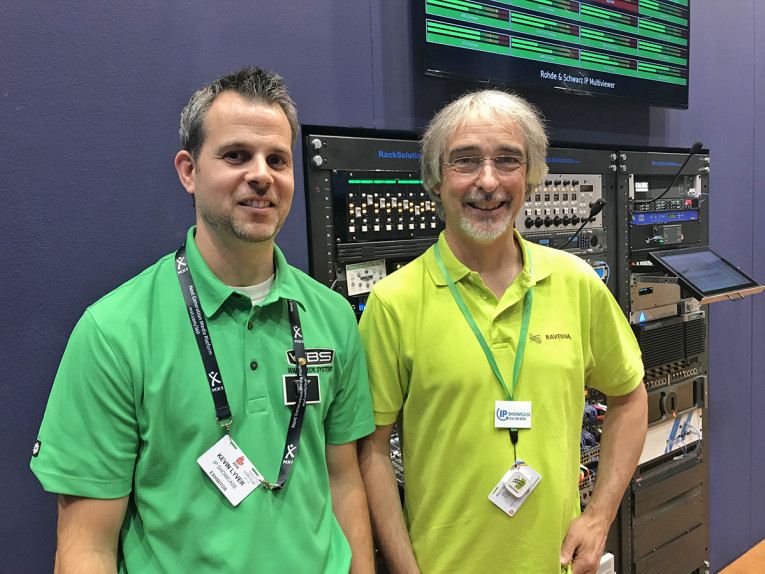
I also learned that Lawo has been gaining a considerable foothold on larger television facilities since its introduction of the Lawo VSM (Virtual Studio Manager) master IP control system. At IBC 2018, the company confirmed a number of important new contracts, including a very large one with CBC/Radio-Canada, Canada’s national public broadcaster, for a planned state-of-the-art facility that will be fully compliant with the SMPTE 2110 standards. All 40 TV channels, 40 Web channels, and 160 Radio channels will be managed with Lawo VSM! At the Amsterdam show, Lawo also announced an impressive number of new audio and video products, including vsmWebPanel, a new touch-optimized HTML5-integrated addition to the Lawo VSM (Virtual Studio Manager) system; a new WAN Edition of its proven A_line family of networked Audio-to-IP interfaces in compact 1RU devices; and the impressive new A_UHD Core with >1,000 fully featured IP DSP Channels, also on just one rack unit. UHD Core is a network-based, software-defined audio DSP engine with unparalleled processing density to expand the capabilities of all Lawo mc2 56 and mc2 96 consoles as only networked architectures allow.
Next up, after learning that Ross was showing new solutions addressing these AoIP challenges, I made sure to visit the impressive booth of the always dynamic Canadian company. In the last few years, Ross has emerged as one of the clear leaders in the broadcast and video production industries, and they have made some strategic acquisitions, which included Coveloz Technologies, a development platform vendor and engineering services company that leads the way in interoperability solutions for AoIP and media networks in general. This was precisely a year ago, and meanwhile, Nestor Amaya, its president, became VP of Infrastructure at Ross. Not surprisingly, Ross has been aggressively expanding its catalog of IP solutions. At the same time, the OEM efforts on the AoIP have continued, and Coveloz core technology is now being applied with a broader vision.
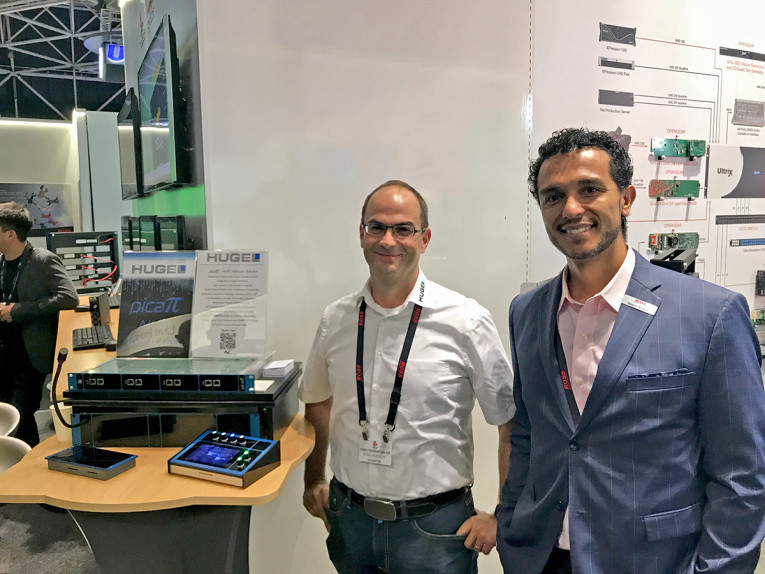
As audioXpress readers might have noticed from the announcement of the new BACH Liberty development solution, Ross has made available a clever new platform that helps audio and video manufacturers deal with this multifaceted reality of AoIP protocols and the ongoing evolution with Video over IP. While Audinate's success with Dante can be attributed to the fact that the company supplies its boards and chips to manufacturers, creating an easy way to implement the protocol on any type of product, solutions for Ravenna, Livewire+, and even AES67 are more complex to implement and are provided by different vendors, which included obviously Coveloz. What Ross has done is to offer a drop-in replacement, pin-compatible module to the popular Dante Brooklyn II board, already featuring Ravenna and a fully compliant AES67 and ST-2110 implementation. In this way, with the BACH Liberty board, manufacturers can use the same design and simply place the board specifically required by the client or the application in question. More importantly, for those manufacturers with Dante solutions, it offers AES67 and ST-2110 without the need for a great investment in development.
To learn if it was that easy, I went to see Nestor Amaya, which introduced me to Theo Hugentobler, from HUGEL, a Swiss company that designs intercom solutions for broadcast, and the first client for the BACH Liberty. Their solution was displayed and is internally a modular frame, which already supported Dante and now can offer all other AoIP options supported by the BACH Liberty, in the same chassis. Of course, as Hugentobler explained, it required a "few days of software tweaking," but it worked and HUGEL now has the solution available to the market, enabling the ability to mix audio with video over converged ST-2110 IP networks. This not only saved HUGEL a lot of time, but also a considerable investment in new hardware development.
And as Amaya reinforced, the BACH Liberty also brings native support of networking solutions such as Dante/SAP, Ravenna, Livewire+, and even EmBER+ and NMOS, all integrated in the same module. This enables manufacturers to focus on the development of their own user interfaces, or to use an off-the-shelf controller, such as ANEMAN (a free of charge Audio NEtwork MANager software solution, which was introduced to control and monitor Ravenna/ST-2110 devices from several manufacturers).
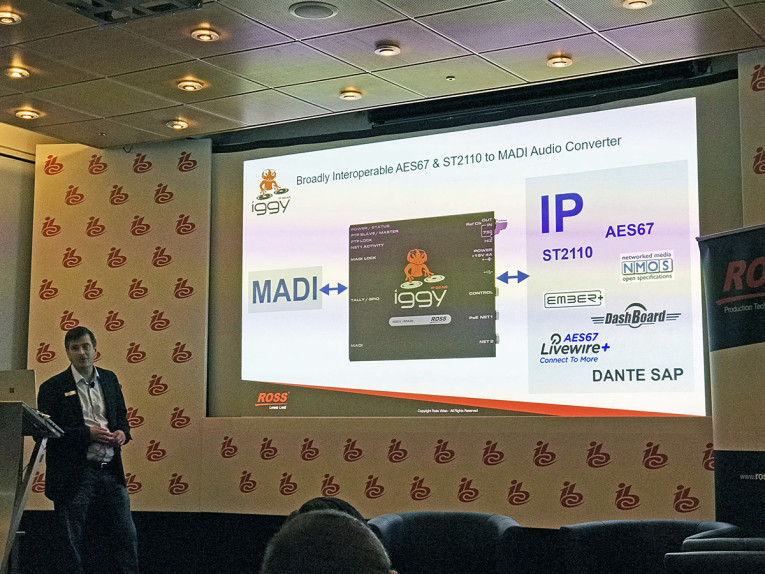
And Ross didn't stop there. In its portfolio of solutions, the Canadian company now offers a range of AES67/ST-2110 solutions, which includes the brand new IGGY converter box, a clever and very useful (at this stage) AES67/ST-2110 to MADI audio converter, with support for NMOS, EmBER+, Dante/SAP, Livewire+, and more environments.
In this complex, diverse, but exciting scenario the requirements will inevitably change and it will not be the audio industry alone that determines the technology in use. The adoption of Next Generation Audio formats will be among the first areas that will need to be addressed, including at the AES67 level. It seems clear the next two years (I'm being optimistic) will be a time to meet these challenging demands, while pushing for audio-specific innovations, operational flexibility, and quality-standards.




